Canon SX620 vs SX740
The Canon PowerShot SX620 HS and the Canon PowerShot SX740 HS are two digital cameras that were announced, respectively, in May 2016 and July 2018. Both the SX620 and the SX740 are fixed lens compact cameras that are equipped with a 1/2.3-inch sensor. Both cameras offer a resolution of 20.2 megapixels.
Below is an overview of the main specs of the two cameras as a starting point for the comparison.

Check SX620 offers at
ebay.com

Check SX740 price at
amazon.com
Going beyond this snapshot of core features and characteristics, what are the differences between the Canon PowerShot SX620 HS and the Canon PowerShot SX740 HS? Which one should you buy? Read on to find out how these two cameras compare with respect to their body size, their imaging sensors, their shooting features, their input-output connections, and their reception by expert reviewers.
Body comparison
An illustration of the physical size and weight of the Canon SX620 and the Canon SX740 is provided in the side-by-side display below. The two cameras are presented according to their relative size. Three successive views from the front, the top, and the rear are shown. All width, height and depth dimensions are rounded to the nearest millimeter.
The SX620 can be obtained in three different colors (black, silver, red), while the SX740 is available in two color-versions (black, silver).
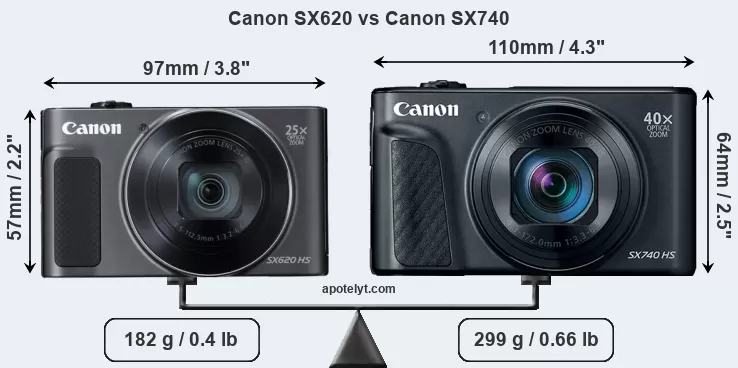
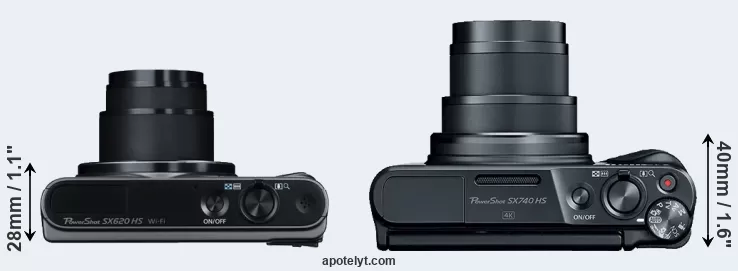
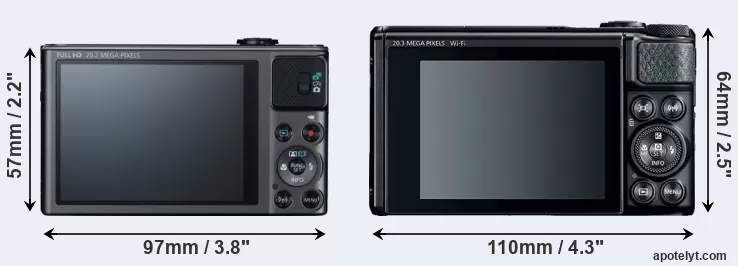
If the front view area (width x height) of the cameras is taken as an aggregate measure of their size, the Canon SX740 is notably larger (27 percent) than the Canon SX620. Moreover, the SX740 is substantially heavier (64 percent) than the SX620. In this context, it is worth noting that neither the SX620 nor the SX740 are weather-sealed.
The power pack in the SX740 can be charged via the USB port, which can be very convenient when travelling.
The following table provides a synthesis of the main physical specifications of the two cameras and other similar ones. If you would like to visualize and compare a different camera combination, you can navigate to the CAM-parator app and make your selection from a broad list of cameras there.

| Camera Model |
Camera Width |
Camera Height |
Camera Depth |
Camera Weight |
Battery Life |
Weather Sealing |
Camera Launch |
Launch Price |
Street Price |
||
|---|---|---|---|---|---|---|---|---|---|---|---|
| 1. | Canon SX620 | 97 mm | 57 mm | 28 mm | 182 g | 295 | n | May 2016 | US$ 279 | ebay.com | |
| 2. | Canon SX740 | 110 mm | 64 mm | 40 mm | 299 g | 265 | n | Jul 2018 | US$ 399 | amazon.com | |
| 3. | Canon G9 X | 98 mm | 58 mm | 31 mm | 209 g | 220 | n | Oct 2015 | US$ 529 | ebay.com | |
| 4. | Canon G9 X Mark II | 98 mm | 58 mm | 31 mm | 206 g | 235 | n | Jan 2017 | US$ 529 | ebay.com | |
| 5. | Canon SX410 | 104 mm | 69 mm | 85 mm | 325 g | 185 | n | Feb 2015 | US$ 279 | ebay.com | |
| 6. | Canon SX420 | 104 mm | 69 mm | 85 mm | 325 g | 195 | n | Jan 2016 | US$ 299 | ebay.com | |
| 7. | Canon SX430 | 104 mm | 69 mm | 85 mm | 323 g | 195 | n | Jan 2017 | US$ 299 | ebay.com | |
| 8. | Canon SX540 | 120 mm | 82 mm | 92 mm | 442 g | 205 | n | Jan 2016 | US$ 399 | ebay.com | |
| 9. | Canon SX610 | 105 mm | 61 mm | 27 mm | 191 g | 270 | n | Jan 2015 | US$ 249 | ebay.com | |
| 10. | Canon SX710 | 113 mm | 66 mm | 35 mm | 269 g | 230 | n | Jan 2015 | US$ 349 | ebay.com | |
| 11. | Canon SX720 | 110 mm | 64 mm | 36 mm | 270 g | 250 | n | Feb 2016 | US$ 379 | ebay.com | |
| 12. | Canon SX730 | 110 mm | 64 mm | 40 mm | 300 g | 250 | n | Apr 2017 | US$ 399 | ebay.com | |
| 13. | Panasonic ZS80 | 112 mm | 69 mm | 42 mm | 327 g | 380 | n | Feb 2019 | US$ 449 | ebay.com | |
| Note: Measurements and pricing do not include easily detachable parts, such as add-on or interchangeable lenses or optional viewfinders. | |||||||||||
Any camera decision will obviously take relative prices into account. The manufacturer’s suggested retail prices give an idea on the placement of the camera in the maker’s lineup and the broader market. The SX620 was launched at a markedly lower price (by 30 percent) than the SX740, which puts it into a different market segment. Normally, street prices remain initially close to the MSRP, but after a couple of months, the first discounts appear. Later in the product cycle and, in particular, when the replacement model is about to appear, further discounting and stock clearance sales often push the camera price considerably down.
Sensor comparison
The imaging sensor is at the core of digital cameras and its size is one of the main determining factors of image quality. A large sensor will generally have larger individual pixels that offer better low-light sensitivity, provide wider dynamic range, and have richer color-depth than smaller pixels in a sensor of the same technological generation. Moreover, a large sensor camera will give the photographer more control over depth-of-field in the image and, thus, the ability to better isolate a subject from the background. On the downside, larger sensors are more costly to manufacture and tend to lead to bigger and heavier cameras and lenses.
Both cameras under consideration feature a 1/2.3-inch sensor and have a format factor (sometimes also referred to as "crop factor") of 5.6. Within the spectrum of camera sensors, this places the review cameras among the smaller-sensor digicams that favor affordability and compact design. Both cameras feature a native aspect ratio (sensor width to sensor height) of 4:3.
Technology-wise, the SX740 uses a more advanced image processing engine (DIGIC 8) than the SX620 (DIGIC 4+), with benefits for noise reduction, color accuracy, and processing speed.
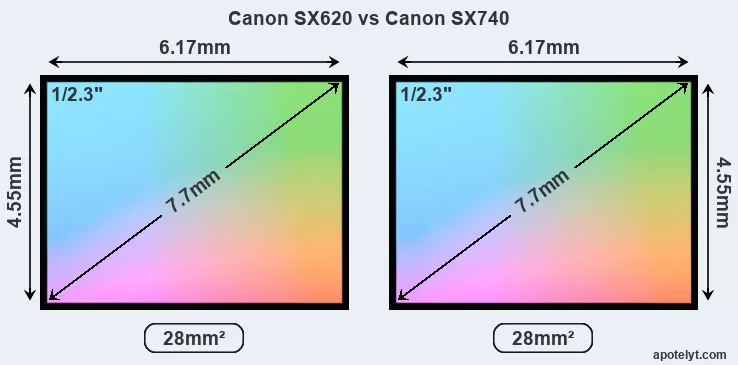
The two cameras under review do not only share the same sensor size, but also offer an identical resolution of 20.2 megapixels. This similarity in sensor specs implies that both the SX620 and the SX740 have the same pixel density, as well as the same pixel size. It should, however, be noted that the SX740 is much more recent (by 2 years and 2 months) than the SX620, and its sensor will have benefitted from technological advances during this time. Coming back to sensor resolution, it should be mentioned that neither of the two cameras has an anti-alias filter installed, so they are able to capture all the detail the sensor resolves.
The Canon PowerShot SX620 HS has a native sensitivity range from ISO 80 to ISO 3200. The corresponding ISO settings for the Canon PowerShot SX740 HS are ISO 100 to ISO 3200 (no boost).
Technology-wise, both cameras are equipped with BSI-CMOS (Backside Illuminated Complementary Metal–Oxide–Semiconductor) sensors. Both cameras use a Bayer filter for capturing RGB colors on a square grid of photosensors. This arrangement is found in most digital cameras.
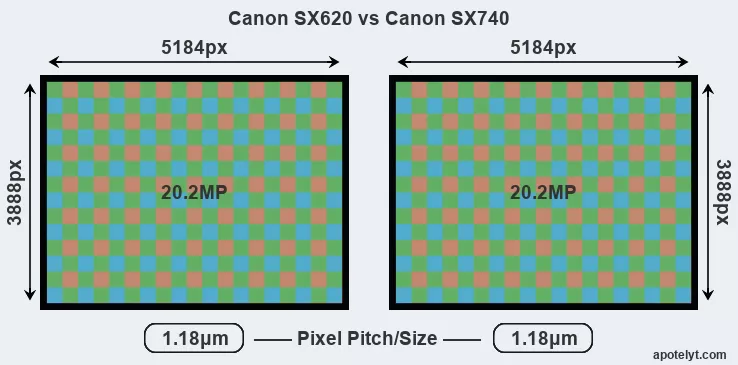
Consistent information on actual sensor performance is available from DXO Mark for many cameras. This service assesses and scores the color depth ("DXO Portrait"), dynamic range ("DXO Landscape"), and low-light sensitivity ("DXO Sports") of camera sensors, and also publishes an overall camera score. The table below summarizes the physical sensor characteristics and sensor quality findings and compares them across a set of similar cameras.

| Camera Model |
Sensor Class |
Resolution (MP) |
Horiz. Pixels |
Vert. Pixels |
Video Format |
DXO Portrait |
DXO Landscape |
DXO Sports |
DXO Overall |
||
|---|---|---|---|---|---|---|---|---|---|---|---|
| 1. | Canon SX620 | 1/2.3 | 20.2 | 5184 | 3888 | 1080/30p | 20.4 | 11.8 | 838 | 49 | |
| 2. | Canon SX740 | 1/2.3 | 20.2 | 5184 | 3888 | 4K/30p | 20.6 | 12.1 | 1050 | 51 | |
| 3. | Canon G9 X | 1-inch | 20.0 | 5472 | 3648 | 1080/60p | 21.5 | 12.3 | 495 | 63 | |
| 4. | Canon G9 X Mark II | 1-inch | 20.0 | 5472 | 3648 | 1080/60p | 21.9 | 12.5 | 522 | 65 | |
| 5. | Canon SX410 | 1/2.3 | 19.9 | 5152 | 3864 | 720/30p | 20.2 | 11.6 | 720 | 47 | |
| 6. | Canon SX420 | 1/2.3 | 19.9 | 5152 | 3864 | 720/25p | 20.3 | 11.7 | 806 | 48 | |
| 7. | Canon SX430 | 1/2.3 | 19.9 | 5152 | 3864 | 720/25p | 20.5 | 11.9 | 900 | 49 | |
| 8. | Canon SX540 | 1/2.3 | 20.2 | 5184 | 3888 | 1080/60p | 20.3 | 11.7 | 806 | 48 | |
| 9. | Canon SX610 | 1/2.3 | 20.2 | 5184 | 3888 | 1080/30p | 20.2 | 11.6 | 712 | 47 | |
| 10. | Canon SX710 | 1/2.3 | 20.2 | 5184 | 3888 | 1080/60p | 20.2 | 11.6 | 712 | 47 | |
| 11. | Canon SX720 | 1/2.3 | 20.2 | 5184 | 3888 | 1080/60p | 20.3 | 11.8 | 817 | 48 | |
| 12. | Canon SX730 | 1/2.3 | 20.2 | 5184 | 3888 | 1080/60p | 20.5 | 11.9 | 924 | 50 | |
| 13. | Panasonic ZS80 | 1/2.3 | 20.2 | 5184 | 3888 | 4K/30p | 20.7 | 12.2 | 1103 | 52 | |
| Note: DXO values in italics represent estimates based on sensor size and age. | |||||||||||
Many modern cameras cannot only take still pictures, but also record videos. The two cameras under consideration both have sensors whose read-out speed is fast enough to capture moving pictures, but the SX740 provides a better video resolution than the SX620. It can shoot movie footage at 4K/30p, while the SX620 is limited to 1080/30p.
Feature comparison
Apart from body and sensor, cameras can and do differ across a range of features. The SX620 and the SX740 are similar in the sense that neither of the two has a viewfinder. The images are, thus, framed using live view on the rear LCD. The following table reports on some other key feature differences and similarities of the Canon SX620, the Canon SX740, and comparable cameras.

| Camera Model |
Viewfinder (Type or 000 dots) |
Control Panel (yes/no) |
LCD Specifications (inch/000 dots) |
LCD Attach- ment |
Touch Screen (yes/no) |
Max Shutter Speed * |
Max Shutter Flaps * |
Built-in Flash (yes/no) |
Built-in Image Stab |
||
|---|---|---|---|---|---|---|---|---|---|---|---|
| 1. | Canon SX620 | none | n | 3.0 / 922 | fixed | n | 1/2000s | 2.5/s | Y | Y | |
| 2. | Canon SX740 | none | n | 3.0 / 922 | tilting | n | 1/3200s | 10.0/s | Y | Y | |
| 3. | Canon G9 X | none | n | 3.0 / 1040 | fixed | Y | 1/2000s | 6.0/s | Y | Y | |
| 4. | Canon G9 X Mark II | none | n | 3.0 / 1040 | fixed | Y | 1/2000s | 8.2/s | Y | Y | |
| 5. | Canon SX410 | none | n | 3.0 / 230 | fixed | n | 1/4000s | 0.5/s | Y | Y | |
| 6. | Canon SX420 | none | n | 3.0 / 230 | fixed | n | 1/4000s | 0.5/s | Y | Y | |
| 7. | Canon SX430 | none | n | 3.0 / 230 | fixed | n | 1/4000s | 0.5/s | Y | Y | |
| 8. | Canon SX540 | none | n | 3.0 / 461 | fixed | n | 1/2000s | 5.9/s | Y | Y | |
| 9. | Canon SX610 | none | n | 3.0 / 922 | fixed | n | 1/2000s | 2.5/s | Y | Y | |
| 10. | Canon SX710 | none | n | 3.0 / 922 | fixed | n | 1/3200s | 6.0/s | Y | Y | |
| 11. | Canon SX720 | none | n | 3.0 / 922 | fixed | n | 1/3200s | 5.9/s | Y | Y | |
| 12. | Canon SX730 | none | n | 3.0 / 922 | tilting | n | 1/3200s | 5.9/s | Y | Y | |
| 13. | Panasonic ZS80 | 2330 | n | 3.0 / 1040 | tilting | Y | 1/2000s | 10.0/s | Y | Y | |
| Note: *) Information refers to the mechanical shutter, unless the camera only has an electronic one. | |||||||||||
The Canon SX740 has an intervalometer built-in. This enables the photographer to capture time lapse sequences, such as flower blooming, a sunset or moon rise, without purchasing an external camera trigger and related software.
Both the SX620 and the SX740 have zoom lenses built in. The SX620 has a 25-625mm f/3.2-6.6 optic and the SX740 offers a 24-960mm f/3.3-6.9 (focal lengths in full frame equivalent terms). Hence, the SX740 provides a wider angle of view at the short end, as well as more tele-photo reach at the long end than the SX620. The SX620 offers the faster maximum aperture.
Concerning the storage of imaging data, both the SX620 and the SX740 write their files to SDXC cards. The SX740 supports UHS-I cards (Ultra High Speed data transfer of up to 104 MB/s), while the SX620 cannot take advantage of Ultra High Speed SD cards.
Connectivity comparison
For some imaging applications, the extent to which a camera can communicate with its environment can be an important aspect in the camera decision process. The table below provides an overview of the connectivity of the Canon PowerShot SX620 HS and Canon PowerShot SX740 HS and, in particular, the interfaces the cameras (and selected comparators) provide for accessory control and data transfer.

| Camera Model |
Hotshoe Port |
Internal Mic / Speaker |
Microphone Port |
Headphone Port |
HDMI Port |
USB Port |
WiFi Support |
NFC Support |
Bluetooth Support |
||
|---|---|---|---|---|---|---|---|---|---|---|---|
| 1. | Canon SX620 | - | mono / mono | - | - | micro | 2.0 | Y | Y | - | |
| 2. | Canon SX740 | - | stereo / mono | - | - | micro | 2.0 | Y | - | Y | |
| 3. | Canon G9 X | - | stereo / mono | - | - | micro | 2.0 | Y | Y | - | |
| 4. | Canon G9 X Mark II | - | stereo / mono | - | - | micro | 2.0 | Y | Y | Y | |
| 5. | Canon SX410 | - | stereo / mono | - | - | - | 2.0 | - | - | - | |
| 6. | Canon SX420 | - | mono / mono | - | - | - | 2.0 | Y | Y | - | |
| 7. | Canon SX430 | - | mono / mono | - | - | - | 2.0 | Y | Y | - | |
| 8. | Canon SX540 | - | stereo / mono | - | - | mini | 2.0 | Y | Y | - | |
| 9. | Canon SX610 | - | - / - | - | - | micro | 2.0 | Y | Y | - | |
| 10. | Canon SX710 | - | stereo / mono | - | - | micro | 2.0 | Y | Y | - | |
| 11. | Canon SX720 | - | stereo / mono | - | - | micro | 2.0 | Y | Y | - | |
| 12. | Canon SX730 | - | stereo / mono | - | - | micro | 2.0 | Y | Y | Y | |
| 13. | Panasonic ZS80 | - | stereo / mono | - | - | micro | 2.0 | Y | - | Y |
The SX740 is a recent model that features in the current product line-up of Canon. In contrast, the SX620 has been discontinued (but can be found pre-owned on ebay). There has not been a direct replacement model for the SX620 from Canon. Further information on the features and operation of the SX620 and SX740 can be found, respectively, in the Canon SX620 Manual (free pdf) or the online Canon SX740 Manual.
Review summary
So how do things add up? Is the Canon SX620 better than the Canon SX740 or vice versa? A synthesis of the relative strong points of each of the models is listed below.
Reasons to prefer the Canon PowerShot SX620 HS:
- Better light gathering: Has a lens with a wider maximum aperture (f/3.2 vs f/3.3).
- More compact: Is smaller (97x57mm vs 110x64mm) and thus needs less room in the bag.
- Less heavy: Is lighter (by 117g or 39 percent) and hence easier to carry around.
- Longer lasting: Can take more shots (295 versus 265) on a single battery charge.
- Easier device pairing: Supports NFC for fast wireless image transfer over short distances.
- More affordable: Was introduced into a lower priced category (30 percent cheaper at launch).
- More heavily discounted: Has been available for much longer (launched in May 2016).
Arguments in favor of the Canon PowerShot SX740 HS:
- Better jpgs: Has a more modern image processing engine (DIGIC 8 vs DIGIC 4+).
- Better video: Provides higher definition movie capture (4K/30p vs 1080/30p).
- More flexible LCD: Has a tilting screen for odd-angle shots in landscape orientation.
- More selfie-friendly: Has an articulated screen that can be turned to be front-facing.
- Faster shutter: Has higher mechanical shutter speed (1/3200s vs 1/2000s) to freeze action.
- Faster burst: Shoots at higher frequency (10 vs 2.5 flaps/sec) to capture the decisive moment.
- Easier time-lapse photography: Has an intervalometer built-in for low frequency shooting.
- Wider view: Has a wider-angle lens that facilitates landscape or interior shots.
- More tele-reach: Has a longer tele-lens for perspective compression and subject magnification.
- Easier travel charging: Can be conveniently charged via its USB port.
- Easier wireless transfer: Supports Bluetooth for image sharing without cables.
- Faster buffer clearing: Has an SD card interface that supports the UHS-I standard.
- More modern: Reflects 2 years and 2 months of technical progress since the SX620 launch.
If the number of relative strengths (bullet points above) is taken as a guide, the SX740 is the clear winner of the contest (13 : 7 points). However, the pertinence of the various camera strengths will differ across photographers, so that you might want to weigh individual camera traits according to their importance for your own imaging needs before making a camera decision. A professional sports photographer will view the differences between cameras in a way that diverges from the perspective of a street photog, and a person interested in family portraits has distinct needs from a landscape shooter. Hence, the decision which camera is best and worth buying is often a very personal one.
How about other alternatives? Do the specifications of the Canon SX620 and the Canon SX740 place the cameras among the top in their class? Find out in the latest Best Superzoom Camera listing whether the two cameras rank among the cream of the crop.
In any case, while the comparison of the spec-sheets of cameras can offer a general idea of their imaging potential, it says little about, for example, the shooting experience and imaging performance of the SX620 and the SX740 in practical situations. User reviews that are available, for instance, at amazon can sometimes shed light on these issues, but such feedback is all too often partial, inconsistent, and inaccurate.
Expert reviews
This is why hands-on reviews by experts are important. The adjacent summary-table relays the overall verdicts of several of the most popular camera review sites (amateurphotographer [AP], cameralabs [CL], digitalcameraworld [DCW], dpreview [DPR], ephotozine [EPZ], photographyblog [PB]). As can be seen, the professional reviewers agree in many cases on the quality of different cameras, but sometimes their assessments diverge, reinforcing the earlier point that a camera decision is often a very personal choice.

| Camera Model |
AP score |
CL score |
DCW score |
DPR score |
EPZ score |
PB score |
Camera Launch |
Launch Price |
Street Price |
||
|---|---|---|---|---|---|---|---|---|---|---|---|
| 1. | Canon SX620 | .. | .. | .. | .. | .. | 4/5 | May 2016 | US$ 279 | ebay.com | |
| 2. | Canon SX740 | .. | + | 3.5/5 | .. | 4/5 | 4/5 | Jul 2018 | US$ 399 | amazon.com | |
| 3. | Canon G9 X | 3.5/5 | + + | .. | .. | 4.5/5 | 4.5/5 | Oct 2015 | US$ 529 | ebay.com | |
| 4. | Canon G9 X Mark II | 4/5 | .. | 4/5 | 75/100 | 4.5/5 | 4.5/5 | Jan 2017 | US$ 529 | ebay.com | |
| 5. | Canon SX410 | .. | o | .. | .. | .. | .. | Feb 2015 | US$ 279 | ebay.com | |
| 6. | Canon SX420 | .. | .. | .. | .. | .. | 3/5 | Jan 2016 | US$ 299 | ebay.com | |
| 7. | Canon SX430 | .. | .. | .. | .. | 3.5/5 | 3.5/5 | Jan 2017 | US$ 299 | ebay.com | |
| 8. | Canon SX540 | .. | .. | .. | .. | .. | .. | Jan 2016 | US$ 399 | ebay.com | |
| 9. | Canon SX610 | .. | .. | .. | .. | 4/5 | 4/5 | Jan 2015 | US$ 249 | ebay.com | |
| 10. | Canon SX710 | .. | + | .. | .. | 4/5 | 3.5/5 | Jan 2015 | US$ 349 | ebay.com | |
| 11. | Canon SX720 | .. | + | .. | .. | 4/5 | 4.5/5 | Feb 2016 | US$ 379 | ebay.com | |
| 12. | Canon SX730 | .. | + | .. | .. | 4/5 | 4/5 | Apr 2017 | US$ 399 | ebay.com | |
| 13. | Panasonic ZS80 | .. | + + | .. | .. | 4.5/5 | .. | Feb 2019 | US$ 449 | ebay.com | |
| Note: (+ +) highly recommended; (+) recommended; (o) reviewed; (..) not available. | |||||||||||
The above review scores should be interpreted with care, though. The ratings were established in reference to similarly priced cameras that were available in the market at the time of the review. Thus, a score needs to be put into the context of the launch date and the launch price of the camera, and comparing ratings of very distinct cameras or ones that are far apart in terms of their release date have little meaning. It should also be noted that some of the review sites have over time altered the way they render their verdicts.

Check SX620 offers at
ebay.com

Check SX740 price at
amazon.com
Other camera comparisons
Did this review help to inform your camera decision process? In case you are interested in seeing how other cameras pair up, just make a corresponding selection in the search boxes below. There is also a set of direct links to comparison reviews that other users of the CAM-parator app explored.
- Canon 1D Mark II N vs Canon SX740
- Canon 6D Mark II vs Canon SX740
- Canon M100 vs Canon SX620
- Canon RP vs Canon SX620
- Canon SX620 vs Nikon 1 J5
- Canon SX620 vs Panasonic TS7
- Canon SX620 vs Sony A6300
- Canon SX620 vs Sony RX1R
- Canon SX740 vs Canon XT
- Canon SX740 vs Leica D-LUX 6
- Canon SX740 vs Nikon D7500
- Canon SX740 vs Ricoh GR II
Specifications: Canon SX620 vs Canon SX740
Below is a side-by-side comparison of the specs of the two cameras to facilitate a quick review of their differences and common features.
| Camera Model | Canon SX620 | Canon SX740 |
|---|---|---|
| Camera Type | Fixed lens compact camera | Fixed lens compact camera |
| Camera Lens | 25-625mm f/3.2-6.6 | 24-960mm f/3.3-6.9 |
| Launch Date | May 2016 | July 2018 |
| Launch Price | USD 279 | USD 399 |
| Sensor Specs | Canon SX620 | Canon SX740 |
| Sensor Technology | BSI-CMOS | BSI-CMOS |
| Sensor Format | 1/2.3" Sensor | 1/2.3" Sensor |
| Sensor Size | 6.17 x 4.55 mm | 6.17 x 4.55 mm |
| Sensor Area | 28.0735 mm2 | 28.0735 mm2 |
| Sensor Diagonal | 7.7 mm | 7.7 mm |
| Crop Factor | 5.6x | 5.6x |
| Sensor Resolution | 20.2 Megapixels | 20.2 Megapixels |
| Image Resolution | 5184 x 3888 pixels | 5184 x 3888 pixels |
| Pixel Pitch | 1.18 μm | 1.18 μm |
| Pixel Density | 71.80 MP/cm2 | 71.80 MP/cm2 |
| Moiré control | no AA filter | no AA filter |
| Movie Capability | 1080/30p Video | 4K/30p Video |
| ISO Setting | 80 - 3,200 ISO | 100 - 3,200 ISO |
| Image Processor | DIGIC 4+ | DIGIC 8 |
| Screen Specs | Canon SX620 | Canon SX740 |
| Viewfinder Type | no viewfinder | no viewfinder |
| LCD Framing | Live View | Live View |
| Rear LCD Size | 3.0inch | 3.0inch |
| LCD Resolution | 922k dots | 922k dots |
| LCD Attachment | Fixed screen | Tilting screen |
| Shooting Specs | Canon SX620 | Canon SX740 |
| Focus System | Contrast-detect AF | Contrast-detect AF |
| Continuous Shooting | 2.5 shutter flaps/s | 10 shutter flaps/s |
| Time-Lapse Photography | no Intervalometer | Intervalometer built-in |
| Fill Flash | Built-in Flash | Built-in Flash |
| Storage Medium | SDXC cards | SDXC cards |
| Single or Dual Card Slots | Single card slot | Single card slot |
| UHS card support | no | UHS-I |
| Connectivity Specs | Canon SX620 | Canon SX740 |
| External Flash | no Hotshoe | no Hotshoe |
| USB Connector | USB 2.0 | USB 2.0 |
| HDMI Port | micro HDMI | micro HDMI |
| Wifi Support | Wifi built-in | Wifi built-in |
| Near-Field Communication | NFC built-in | no NFC |
| Bluetooth Support | no Bluetooth | Bluetooth built-in |
| Body Specs | Canon SX620 | Canon SX740 |
| Battery Type | Canon NB-13L | Canon NB-13L |
| Battery Life (CIPA) | 295 shots per charge | 265 shots per charge |
| In-Camera Charging | no USB charging | USB charging |
| Body Dimensions |
97 x 57 x 28 mm (3.8 x 2.2 x 1.1 in) |
110 x 64 x 40 mm (4.3 x 2.5 x 1.6 in) |
| Camera Weight | 182 g (6.4 oz) | 299 g (10.5 oz) |

Check SX620 offers at
ebay.com

Check SX740 price at
amazon.com
Did you notice an error on this page? If so, please get in touch, so that we can correct the information.

